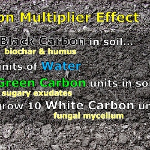
AgroEcocultural Geoengineering by Erich J. Knight
Pitch
Allow Soil Biology to rapidly & massively draw down CO2, offset ongoing & past CO2e, Safely & Naturally restore H2O cycles & cloud cooling
Description
Summary
Soil Biology is our only way to rapidly and massively draw down CO2 from the air to offset our ongoing and past carbon emissions, It Could safely and naturally restore the hydrological cycles by increasing biogenic aerosols and cloud albedo that could readily cool the planet by the 3 watts/m2 needed to offset the now locked in greenhouse warming effects and avoid the Storms of Our Grandchildren.
A combination of Best Management Practices, (BMPs), for Agriculture, Grazing & Forestry with bioenergy systems which build soil carbon can deliver the giga-tons of carbon necessary into the soil sink bank. [1]
Ag BMPs; 1 GtC
New Forest & BMPs; 1 GtC
Pyrolitic Bioenergy, Cooking Stoves; 0.83 MtCO2e
Industrial Pyrolitic Bioenergy; 2 GtC
Holistic Grazing; 2+ GtC
Over 6 GtC,
So soils & biota can do more than half the 10 GtC reduction job.
Simple Extrapolations to show the potential Climate & Soil Impacts;
Based on the "Son of A Billion Ton" biomass resource study by ORNL.
Total 2030 Biomass Harvest in the US; 1.6 Billion Tons
If All was processed by CoolPlanet Bioenergy Systems, into carbon negative fuels,(1 ton yielding 50 gallons & 1/3 ton biochar), the total Yield would be;
80 Billion Gallons of tank ready fuel , (The US uses 130 Billion gallons/yr),
528 Million Tons of Biochar , (Surface Area; 400 Square Meters/Gram),
One Ton has a surface area of 90,000 Acres!, 140 square miles!!
528 Million Tons of Biochar equals 74 Billion Square Miles, or 375 times the Entire Surface of the Earth!, or 1.85 GtCO2e, (34% of US annual emissions)
It would require just 8,000 distributed CP-Biorefineries. (each producing 10 Mgal/yr)
According to Dr Hansen's formula for assessing national CO2 liabilities,
The US CO2 reduction fraction is;
26.3 PPM = 207GtCO2 = 56 GtC
Clean Biomass cooking is no small thing.
The World Bank Study;
Biochar Systems for Smallholders in Developing Countries: Leveraging Current Knowledge and Exploring Future Potential for Climate-Smart Agriculture
http://fb.me/38njVu2qz
A very exacting analysis of biomass usage & sources, energy & emissions. Also for Onion farmers in Senegal and Peanut farmers in Vietnam.
Extrapolation made from the Kenya cook stove study, assuming 250M TLUDs, (Top-Lite Up Draft) Cook Stoves for the roughly 1 billion folks world wide now using open burning. A TLUD per Household of 4, producing 0.52 tons char/Household/yr, X 250M = 130 Mt Char/yr Sequestration of 130 Million tons of Biochar per year, could be achieved just from cooking.
In terms of CO2e, these 250M Households reduce 825M Tons of CO2e annually. The cascading pulmonary health benefits for woman & children is the very thick icing on this 0.825 GtCO2e Soil Carbon Cake.
[1]
Global Cooling by Grassland Soils of the Geological Past and Near Future
http://blogs.uoregon.edu/gregr/files/2013/07/Retallack-2013-grassland-cooling-q8ay9r.pdf
Emerging land use practices rapidly increase soil organic matter
http://www.nature.com/ncomms/2015/150430/ncomms7995/abs/ncomms7995.html
Which plan do you select for China?
Cooling Climate Change in China!Which plan do you select for India?
Cooling Climate Change in India!Which plan do you select for the United States?
Cooling Climate Change in the United States!Which plan do you select for Europe?
Europe CO2 Soil Sequestration via Plant Root Mass Using a Renewable Abiotic EPSWhich plan do you select for other developing countries?
Cooling Climate Change in Developing Countries!Which plan do you select for other developed countries?
PYROLYSIS OF WASTE AS A RENEWABLE ENERGY SOURCE IN RURAL AREASWhat additional cross-regional proposals are included in your plan, if any?
How do the regional and cross-sectoral plans above fit together?
Building Soils, building biology to reverse climate change. All the while providing food security, increased fertility, alternative carbon negative energy
At the Conference of Parties (COP) 21 in Paris Follow the lead of the French ministry of agriculture. In the framework of a "working meeting" on April 28, the French Minister of agriculture Stéphane Le Foll, the French Ambassador to Paris Climate 2015, Ms. Laurence Tubiana, brought her full and enthusiast support to carbon farming.
"Despite the need to improve measurement capacities in agriculture", Tubiana thinks after REDDs, the time has come to include agriculture, in particular to bring in developing countries in international negotiations on the climate. She said:
"we can fight global warming and improve food security", "damaged lands are often in poor countries", "the 4 / 1000 international research problem is emblematic of what we have to do", "it is a research and action program to transform agriculture", "agro-ecology is the turning point we are about to take".
Explanation of the emissions scenario calculated in the Impact tab
What are the plan’s key benefits?
World farmers rebuilding their Soil Carbon stocks.
Restoration of hydrologic cycles, return of ground water,
Healthy pastures & people
Energy independence
What are the plan’s costs?
Self financing IF soil carbon is recognized for the values normally externalized.
The invisible hand of CO2e needs to be made manifest by policy, the same for NPK, nutrients in the wrong place have social/ecological cost, in the right places high values. Carbon in the right place tremendous soil values. These now mostly "Externalized Values" for society, hydrology, ecology, soils etc. must be placed on the balance sheet.
What are the key challenges to enacting this plan?
Global recognition of soil carbon's restorative value to the climate.
Timeline
Follow the French at COP21
References
Food and farming under climate change: moving towards a global agreement
Re-Building the World's Soil: The Role of Soil Carbon Methodology for U.S. and Global Carbon Offset Projects,
http://www.prweb.com/releases/2012/12/prweb10185341.htm
FAO on Conservation Agricultural:
On 5 billion hectares of agricultural land, this could represent one-third of the current annual global emission of CO2 from the burning of fossil fuels (i.e., 27 Pg CO2 per year)." http://www.fao.org/ag/ca/doc/CA_SSC_Overview.pdf
Evidence Supporting Holistic Management (HM)
http://www.savoryinstitute.com/wp-content/uploads/2013/03/Savory_Inst_HM_Research_Portfolio_March2013.pdf
Technical Working Group on Agricultural Greenhouse Gases (T-AGG)
https://nicholasinstitute.duke.edu/focal-areas/technical-working-group-agricultural-greenhouse-gases-t-agg#.VdpdE5e6Xuc